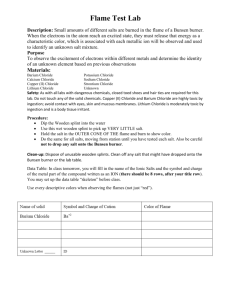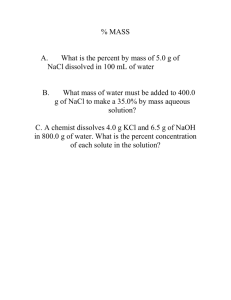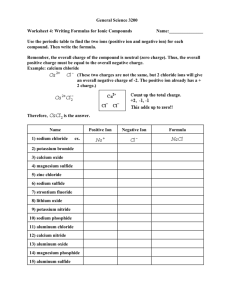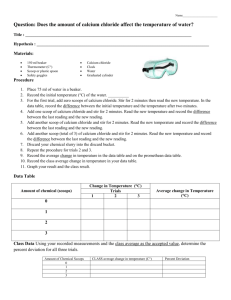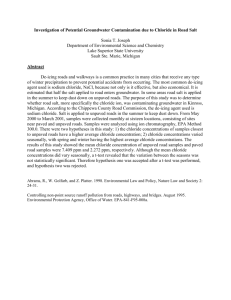Sodium Chloride - Paramount Pools
advertisement
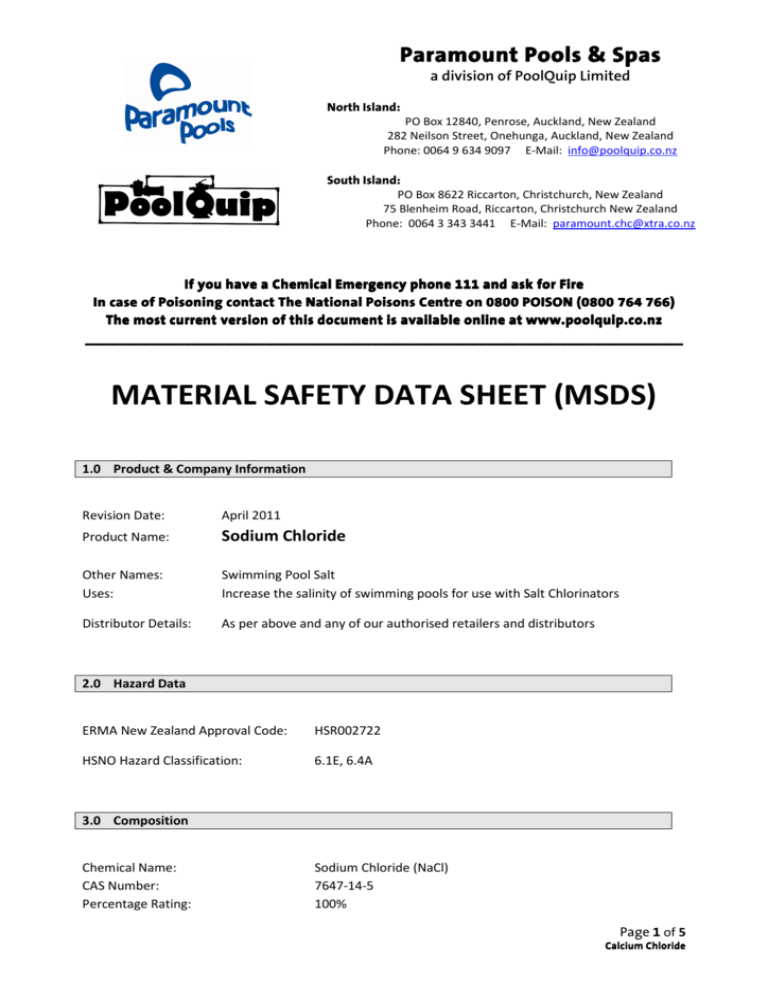
Paramount Pools & Spas a division of PoolQuip Limited North Island: PO Box 12840, Penrose, Auckland, New Zealand 282 Neilson Street, Onehunga, Auckland, New Zealand Phone: 0064 9 634 9097 E-Mail: info@poolquip.co.nz South Island: PO Box 8622 Riccarton, Christchurch, New Zealand 75 Blenheim Road, Riccarton, Christchurch New Zealand Phone: 0064 3 343 3441 E-Mail: paramount.chc@xtra.co.nz If you have a Chemical Emergency phone 111 and ask for Fire In case of Poisoning contact The National Poisons Centre on 0800 POISON (0800 764 766) The most current version of this document is available online at www.poolquip.co.nz ________________________________________________________________________ _________________________________________________________________________ ____________________________ MATERIAL SAFETY DATA SHEET (MSDS) 1.0 Product & Company Information Revision Date: April 2011 Product Name: Sodium Chloride Other Names: Uses: Swimming Pool Salt Increase the salinity of swimming pools for use with Salt Chlorinators Distributor Details: As per above and any of our authorised retailers and distributors 2.0 Hazard Data ERMA New Zealand Approval Code: HSR002722 HSNO Hazard Classification: 6.1E, 6.4A 3.0 Composition Chemical Name: CAS Number: Percentage Rating: Sodium Chloride (NaCl) 7647-14-5 100% Page 1 of 5 Calcium Chloride 4.0 First Aid Measures Description of necessary measures according to routes of exposure. Swallowed: Vomiting will probably occur. Provided the patient is conscious give plenty of liquid to drink. Obtain immediate medical attention especially if vomiting has not occurred. Eyes: Irrigate with eyewash solution or water. If symptoms develop obtain medical help. Skin: Wash with plenty of water. Inhaled: Remove patient to fresh air. Keep warm and at rest. Give drinks if desired. Advice to Doctor: Treat symptomatically based on individual reactions of patient and judgement of doctor. Give water to drink. No need to induce vomiting. Irrigate eyes with copious quantities of slow flowing water for up to 15 minutes. Eyelids to be held open. Brush off clothing and wash skin thoroughly with water. Aggravated medical No information available on medical conditions which are aggravated from exposure to this product. 5.0 Fire Fighting Measures Extinguishing Media Use agents suitable for type of surrounding fire (dry chemical, CO2, water spray or foam) Take into account other chemicals in the surrounding area. Hazards from Combustion Products Salt withstands temperatures up to its melting point and beyond without decomposing, but at very high temperatures (greater than approximately 800 Deg C) a vapour may be emitted which is particularly irritating to the eyes. Special Protective Precautions and Equipment for Fire Fighters As applicable to the combustion products associated with the fire Flammability Conditions Product is a non-flammable solid. Hazchem Code N/A Page 2 of 5 Calcium Chloride 6.0 Accidental Release Measures Emergency Procedures Avoid prolonged contact with the skin and inhalation of dust concentrations, otherwise normal good handling and housekeeping practice is adequate. No special protective clothing is required. Methods and Materials for Containment and Clean Up Spillages should be swept up or may be safely water hosed to drain under normal circumstances. 7.0 Handling & Storage Precautions for Safe Handling Salt dust is non-flammable but static electricity can be generated by pneumatic conveying, therefore pipes should be bonded and earthed, especially in environments where a spark could prove hazardous. Conditions for Safe Storage (Including any compatibles) Due to its hydroscopic nature, salt should be stored in a dry atmosphere and away from concentrated acids. Absorbs moisture if the relative humidity is above 75%. Container Type This product comes pre packaged in 25kg Bags. 8.0 Exposure Controls / Personal Protection Occupational Exposure As total dust 10mg/m3 (8 hours TWA) Limits As respirable dust 4mg/m3 (8 hours TWA) Dangerous Exposure Non Specified Engineering Controlls Static electricity can be generated by pneumatic conveying, therefore pipes should be bonded and earthed, especially in environments where a spark could prove hazardous 9.0 Physical and Chemical Properties Appearance Formula Odour Vapour Pressure Vapour Density Boiling Point Crystalline Solid, white / colourless NaCl None 2.4mm Hg at 747 Deg C 2.165 gm / cc (of crystalline solid at 20 Deg C) 1413 Deg C Page 3 of 5 Calcium Chloride Melting Point Solubility in Water Specific Gravity Flash Point pH Rate of Solid Materials Decomposition Temperature Additional Information 802 Deg C 35.9 g/100g at 0 Deg C, 39.2 g/100g at 100 Deg C Not applicable Non-flammable Not available No data available No data available No data available 10.0 Stability and Reactivity Chemical Stability Stable Conditions to Avoid Reacts with strong sulphuric acid or nitric acid to give hydrogen chloride gas Incompatible Materials Under wet conditions can corrode many common metals, particularly iron, aluminium and zinc. Stainless steel and monel resist attack. Hazardous Decomposition Products Trace amounts of hydrogen chloride gas may be evolved at temperatures in excess of 800 Deg C. Contains no water of crystallization. Does not react with alkalis at ordinary temperatures. Hazardous Reactions 11.0 Toxicological Information Swallowed Salt is an essential constituent of the diet. It provides important body electrolytes and is the source of hydrochloric acid present in the gastric juices. The blood stream contains nearly 1% sodium chloride. In normal industrial use salt is non-hazardous. LD50 3000mg/kg oral, rat Eye Dust may be irritating. Skin Irritation after prolonged contact Inhaled Dusts may be irritating 12.0 Ecological Information A maximum value of 412 mg/L ensures the protection of all aquatic life Page 4 of 5 Calcium Chloride 13.0 Disposal Considerations Disposal Refer to the Local council bylaws and Land Waste Management Authority. Dissolved material in excess water is normally suitable for disposal in storm water system. 14.0 Transport Information Land and Sea Transport UN Number Shipping Name Dangerous Goods Class Packing Group Hazchem Code Not applicable Sodium Chloride Not applicable Not applicable Not applicable 15.0 Regulatory Information Poisons Schedule EPG AICS Name NZ Toxic Substance HSNO Hazard Classification ERMA Approval Code N/A N/A Calcium Chloride N 6.1E and 6.4A HSR002722 16.0 Other Information None Page 5 of 5 Calcium Chloride
